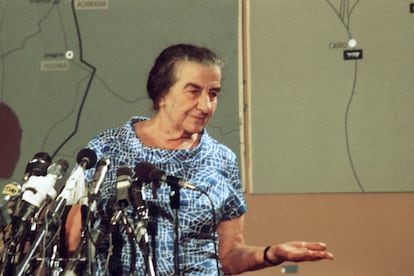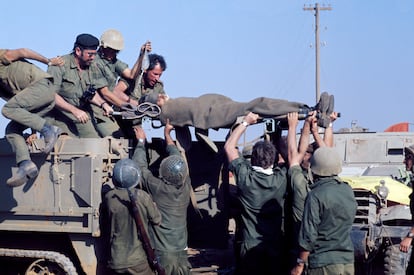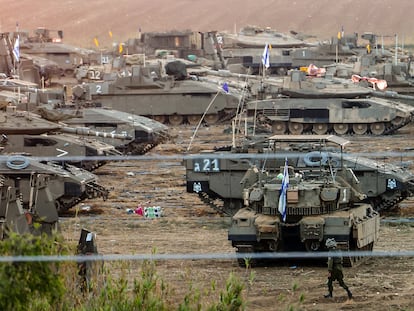Yom Kippur War: 50 years from the war that led to peace between Egypt and Israel
Also known as the 1973 Arab-Israeli War, this armed conflict had significant implications in the Middle East

The Yom Kippur War is also known as the Ramadan War, the October War, or the 1973 Arab-Israeli War. It’s referred to as the Fourth Arab-Israeli War because it was the fourth armed conflict between these two forces in the ongoing Arab-Israeli conflict, which had escalated since Israel’s Declaration of Independence in 1948.
The conflict was rooted in longstanding tensions in the Middle East. Since Israel’s establishment, countries like Egypt and Syria refused to recognize its legitimacy and vowed to reclaim territories lost in the 1967 Arab-Israeli War, including the Sinai Peninsula and the Golan Heights. Political, ideological, and territorial disputes made the region volatile, and war seemed inevitable. The war was short, lasting only two weeks and five days, from October 6 to October 25, 1973, beginning with a surprise attack by the Arab states.
On October 7, 2023, 50 years and one day after the start of the Yom Kippur War, Hamas — the military organization governing the Gaza Strip of the Palestinian territories — launched an attack on Israel, which led to the current 2023 Israel-Hamas war, the latest clash in the Palestine-Israel conflict that has been ongoing since 2006.
The war
On October 6, 1973, during Yom Kippur, the holiest day in Judaism and the 10th day of the Islamic holy month of Ramadan, both Egypt and Syria launched a coordinated surprise attack on Israel. Egyptian forces crossed the Suez Canal and advanced into the Sinai Peninsula, while Syrian forces assaulted the Golan Heights, quickly gaining control. Despite initial setbacks, Israel’s leadership, Prime Minister Golda Meir and Defense Minister Moshe Dayan, mobilized its military and launched a counteroffensive. After three days of fighting, Israel stopped the Egyptian offensive, resulting in a stalemate on that front, and pushed the Syrians back to the ceasefire lines established before the war. Israel then launched a military counter-offensive into Syria for four days, eventually shelling the outskirts of Damascus, Syria’s capital, within a week.

Following the outbreak of the war, both the United States and the Soviet Union initiated resupply efforts to their respective allies (Israel and the Arab States), leading to heightened tensions and a confrontation between the two nuclear-armed superpowers, becoming a separate episode of the Cold War. Egypt and Syria received support from Saudi Arabia, Algeria, Jordan, Iraq, Libya, Kuwait, Tunisia, Morocco, Cuba, and North Korea.
On October 22, an initial ceasefire mediated by the United Nations fell apart, with both sides blaming each other for the violation. By October 24, the Israelis had substantially enhanced their positions and successfully encircled the Egyptian Third Army and Suez City, bringing them within approximately 100 kilometers (62 miles) of the Egyptian capital, Cairo. Recognizing that further military actions might strain relations with the United States and that they might not always be capable of dominating the Arab states in a larger war, Israel’s leadership agreed to a second ceasefire on October 25, 1973, marking the official end of the war through collaborative efforts.
This led to the Camp David Accords, a pair of political agreements signed by Egyptian President Anwar Sadat and Israeli Prime Minister Menachem Begin on September 17, 1978. The accords were signed after twelve days of secret negotiations at Camp David, the country retreat of then-President of the United States Jimmy Carter, in Maryland, U.S. The first agreement, called “A Framework for Peace in the Middle East,” which addressed the Palestinian territories, was written without the participation of the Palestinians or the United Nations. The UN General Assembly rejected it because it did not comply with the Palestinian right of return, self-determination, and national independence and sovereignty. The second covenant, called “A Framework for the Conclusion of a Peace Treaty between Egypt and Israel,” led to the 1979 Egypt-Israel peace treaty, which has lasted since its implementation.

The effects
The Camp David Accords eroded the unity of Arab nations in their opposition to Israel. Egypt’s shift in allegiance created a power vacuum, and Saddam Hussein of Iraq, once considered a secondary player, aimed to exploit this void. The ambiguity surrounding the implementation of Resolution 242 elevated the Palestinian predicament to the forefront of the Arab-Israeli conflict. Many Arab states held Egypt responsible for not exerting enough pressure on Israel to address the Palestinian issue in a manner that met their expectations. Additionally, Syria conveyed to Egypt that reconciliation would be impossible unless Egypt renounced its peace agreement with Israel.
The Yom Kippur War significantly influenced U.S. military doctrine and strategic thinking. In the aftermath of the conflict, American military leaders, including Gen. Creighton Abrams and Gen. William E. DePuy, recognized the value of studying Israel’s war-fighting tactics, which they considered analogous to NATO’s situation in Europe. U.S. military analysts and senior officers, such as Gen. Donn A. Starry, visited Israel to extract valuable lessons from the Yom Kippur War. These lessons included the enhanced effectiveness of anti-tank and anti-aircraft missiles, the importance of rigorous training for tank crews, the necessity of effective cover and concealment during movement, and the significance of combined arms warfare. As a result of these insights, the U.S. Army revised its operational concept to focus on “Active Defense,” emphasizing tactical proficiency and the integration of advanced weapon systems observed during the war.
Sign up for our weekly newsletter to get more English-language news coverage from EL PAÍS USA Edition
Tu suscripción se está usando en otro dispositivo
¿Quieres añadir otro usuario a tu suscripción?
Si continúas leyendo en este dispositivo, no se podrá leer en el otro.
FlechaTu suscripción se está usando en otro dispositivo y solo puedes acceder a EL PAÍS desde un dispositivo a la vez.
Si quieres compartir tu cuenta, cambia tu suscripción a la modalidad Premium, así podrás añadir otro usuario. Cada uno accederá con su propia cuenta de email, lo que os permitirá personalizar vuestra experiencia en EL PAÍS.
¿Tienes una suscripción de empresa? Accede aquí para contratar más cuentas.
En el caso de no saber quién está usando tu cuenta, te recomendamos cambiar tu contraseña aquí.
Si decides continuar compartiendo tu cuenta, este mensaje se mostrará en tu dispositivo y en el de la otra persona que está usando tu cuenta de forma indefinida, afectando a tu experiencia de lectura. Puedes consultar aquí los términos y condiciones de la suscripción digital.
More information
Archived In
Últimas noticias
Most viewed
- Reinhard Genzel, Nobel laureate in physics: ‘One-minute videos will never give you the truth’
- Oona Chaplin: ‘I told James Cameron that I was living in a treehouse and starting a permaculture project with a friend’
- Pablo Escobar’s hippos: A serious environmental problem, 40 years on
- Why we lost the habit of sleeping in two segments and how that changed our sense of time
- Charles Dubouloz, mountaineering star, retires at 36 with a farewell tour inspired by Walter Bonatti










































